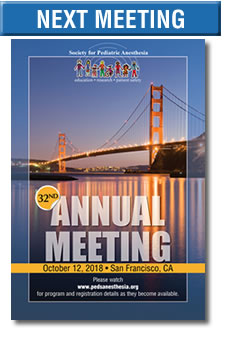Report of the Chair of the Section on Anesthesiology, the American Academy of Pediatrics
 By Rae Brown, MD, FAAP
By Rae Brown, MD, FAAP
Section Chair
The focus on advocacy for the health and safety of children continues within the American Academy of Pediatrics. The Section on Anesthesiology and Pain Medicine has been involved in this work locally and nationally. Currently, three areas remain problematic and require our continued focus – gun violence, opioids, and immigration. Recent discussions at the Spring meeting of the AAP Section and the Society for Pediatric Anesthesia provided a forum for discussions on each of these. The desire of the leadership of the Society for Pediatric Anesthesia to join with the Academy in addressing these problems and offering solutions reflects the further development of both organizations and the relationship between two outstanding professional groups. Together, the AAP and the SPA provide not only a forum for discussion but the involvement of some the brightest pediatric care providers working in the best interests of children. We will continue to involve the leadership of the Society for Pediatric Anesthesia in our efforts and will report regularly to the membership concerning child advocacy issues. Any member of the SPA who wants to work toward solutions to these monumental social problems is always welcome.
The most recent joint meeting in Phoenix was one of the best I have experienced in nearly thirty years of involvement. The organization was superb, the educational opportunities were substantial, and there were many chances to network. Much of the credit for the success of this meeting must be given to the meeting program director Peggy McNaull, from UNC and to the chair of the education committee of the AAP section, Courtney Hardy. The AAP Advocacy lecture by Dr. Marsha Griffin was revealing, as she spoke about her experience caring for thousands of children coming across the border in south Texas. These children are being mistreated, and the AAP is working diligently to change that circumstance, advocating against anti-immigrant policies because of their impact on child health and well-being. Dr. Griffin's stories were instructive and emotionally charged.
One of the roles of the Section on Anesthesiology and Pain Medicine of the AAP is to inform all of our pediatric colleagues about the work that we do. The process of providing safe sedation, anesthesia and perioperative care to children is a part of medicine that most clinicians are not familiar with. This lack of knowledge often triggers anxiety in the primary care providers of children which can transferred to parents. A lack of basic knowledge about the impact of intercurrent illness, whether acute or chronic, on the conduct of anesthetics and surgical procedures on infants and children may increase risk. In our dealings with colleagues, it is essential for each of us to provide gentle teaching so that we might be better understood. It is in the interest of our patients and ourselves.
The Section is involved in a variety of educational platforms for the general pediatrician and pediatric subspecialist within the AAP. The reach is broad as we are speaking to nearly seventy thousand clinicians, each with a vested interest in seeing that the perioperative care of their patient is the best that it can be. Many of our educational offerings are at the National Conference and Exhibition of the AAP in the Fall. In the past, members of the section have provided expertise to teach about pain medicine in children including alternatives to the use of opioids, about the perioperative management of acute illness, as well as the fundamental ways that chronic disease affects the conduct of general anesthesia.
Members of the Section have been busy helping pediatricians understand the toxicities of general anesthetic agents and the need to balance the risks of an intervention with the benefits in every one of our patients. We have spoken to the role that obesity and obstructive sleep apnea in children has changed the management of patients. Also, we have apprised all of the critical roles that anesthesiologists have in the management of children that are the victims of trauma. We have produced webinars, written books, published articles, and provided detailed explanations in newsletters for many sections of the AAP. All of this is done for education, communication, and increasing the safe perioperative care of every child.
The leadership of the Society for Pediatric Anesthesia and the Section on Anesthesiology of the American Academy of Pediatrics continue to look for areas of common concern, for our patients and our profession. It is a great time to be a pediatric anesthesiologist.






